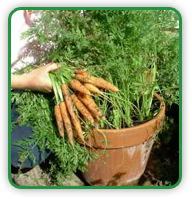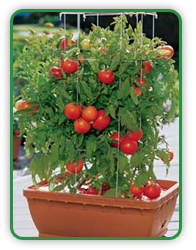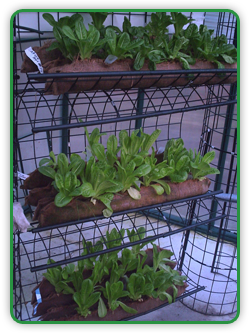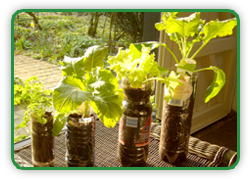|
Home > Guides > Urban Gardening > Container Gardening > Micro Gardening |
|
Micro Gardening |
Container  Mini Gardens Mini Gardens  Micro Gardens Micro Gardens |
For obvious reasons, most crops have been traditionally cultivated in open spaces such as gardens and fields. These environments offer ample sunlight and an abundance of space for plants to grow. Growing vegetables or herbs in Container Gardens (also known as Mini or Micro Gardens), on the other hand, requires resourcefulness and careful planning to produce sizable yields for survival. Fortunately this approach affords the attentive gardener greater flexibility and control over the growing medium. With these tools, a healthy and abundant harvest can be secured even in the most challenging locations.
|
 |
|
|
| |
|
|
| |
|
|
| |
Container Gardening
Types of Containers
 A wide variety of containers can be used to cultivate container gardens, including raised beds, window boxes, ceramic pots, old claw-foot bathtubs, and whatever else is easily available. Anything that has housed potentially harmful substances, such as old paint cans, should be avoided. Containers with open bottoms or holes in the bottom will allow for good drainage, but are not necessarily ideal as nutrients and minerals leached from the soil will drain out as well. If using a container with a sealed bottom, it is recommended to line the bottom with stones or something similar to allow for drainage and prevent the bottom of your container from becoming excessively A wide variety of containers can be used to cultivate container gardens, including raised beds, window boxes, ceramic pots, old claw-foot bathtubs, and whatever else is easily available. Anything that has housed potentially harmful substances, such as old paint cans, should be avoided. Containers with open bottoms or holes in the bottom will allow for good drainage, but are not necessarily ideal as nutrients and minerals leached from the soil will drain out as well. If using a container with a sealed bottom, it is recommended to line the bottom with stones or something similar to allow for drainage and prevent the bottom of your container from becoming excessively  moist. moist.
Special Considerations for the Indoor Container Grower
Container gardening can be very productive for city dwellers or others with limited space or topsoil. Growing such gardens indoors is especially attractive to such people as these environments offer greater year-round stability of heat and humidity. Crops that require less time to grow, such as greens and microgreens, make the best choices for indoor cultivation. Other options to improve light conditions, including using shelves, supplementing with artificial lighting, moving container gardens to maximize light exposure, using reflectors, and constructing makeshift greenhouses can all be utilized to offset the potential challenges to indoor container gardening.
|
| |
|
|
|
| |
|
|
|
|
Planning Your Container Micro Gardener
 Limited space is no deterrent to growing and enjoying your own container micro garden. Just about any sizable container can be converted into a micro garden capable of yielding a bountiful harvest. When considering containers, large plastic tubs are an attractive choice due to their durability, low cost, and ease of conversion into a self-watering unit. Such a unit will provide consistent water to the growing root structures and promote more even growth to a wide array of container crops, including root vegetables. The stresses on plants from watering from above is eliminated as well, and with a fertile growing medium, and nutrients will be retained in the soil longer. If maintained properly, these units will require less frequent fertilizing and watering. Limited space is no deterrent to growing and enjoying your own container micro garden. Just about any sizable container can be converted into a micro garden capable of yielding a bountiful harvest. When considering containers, large plastic tubs are an attractive choice due to their durability, low cost, and ease of conversion into a self-watering unit. Such a unit will provide consistent water to the growing root structures and promote more even growth to a wide array of container crops, including root vegetables. The stresses on plants from watering from above is eliminated as well, and with a fertile growing medium, and nutrients will be retained in the soil longer. If maintained properly, these units will require less frequent fertilizing and watering.
 Crops and Soil for the Micro Garden Crops and Soil for the Micro Garden
A variety of greens can be grown with relatively little energy in most environments. With additional sunlight, soil and containers, a much broader range of edibles can be cultivated. Cherry tomatoes make an excellent choice for a pleasing and productive hanging basket. Vertical climbers, such as pole beans and Malabar Spinach, can be grown on trellis or other supports with compact containers at their base providing nutrition and stability. Root vegetables such as beets, turnips, and some varieties of dwarf carrots, can be grown with eight inches of soil or less. Cultivating a healthy, fast growing mini garden requires a fertile, lively growing medium. Over time, watering and growing plants can begin to take a toil on the soil. For best results, recycle your soil and amend annually to ensure an ideal environment for your crops.
|
|